YAMAHA FX HO CRUISER 2022 Owner's Manual
Manufacturer: YAMAHA, Model Year: 2022, Model line: FX HO CRUISER, Model: YAMAHA FX HO CRUISER 2022Pages: 136, PDF Size: 5.62 MB
Page 21 of 136
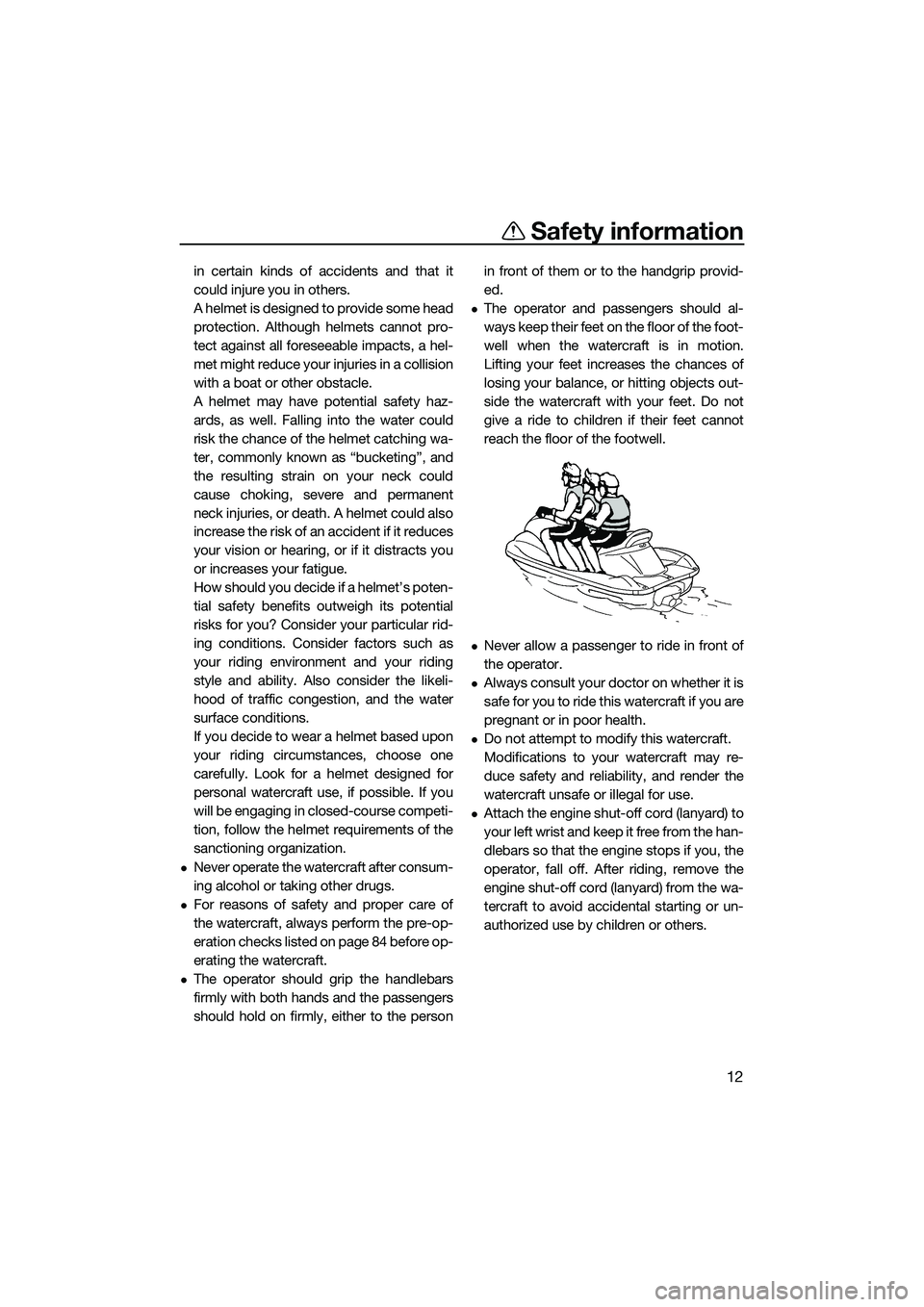
Safety information
12
in certain kinds of accidents and that it
could injure you in others.
A helmet is designed to provide some head
protection. Although helmets cannot pro-
tect against all foreseeable impacts, a hel-
met might reduce your injuries in a collision
with a boat or other obstacle.
A helmet may have potential safety haz-
ards, as well. Falling into the water could
risk the chance of the helmet catching wa-
ter, commonly known as “bucketing”, and
the resulting strain on your neck could
cause choking, severe and permanent
neck injuries, or death. A helmet could also
increase the risk of an accident if it reduces
your vision or hearing, or if it distracts you
or increases your fatigue.
How should you decide if a helmet’s poten-
tial safety benefits outweigh its potential
risks for you? Consider your particular rid-
ing conditions. Consider factors such as
your riding environment and your riding
style and ability. Also consider the likeli-
hood of traffic congestion, and the water
surface conditions.
If you decide to wear a helmet based upon
your riding circumstances, choose one
carefully. Look for a helmet designed for
personal watercraft use, if possible. If you
will be engaging in closed-course competi-
tion, follow the helmet requirements of the
sanctioning organization.
Never operate the watercraft after consum-
ing alcohol or taking other drugs.
For reasons of safety and proper care of
the watercraft, always perform the pre-op-
eration checks listed on page 84 before op-
erating the watercraft.
The operator should grip the handlebars
firmly with both hands and the passengers
should hold on firmly, either to the person in front of them or to the handgrip provid-
ed.
The operator and passengers should al-
ways keep their feet on the floor of the foot-
well when the watercraft is in motion.
Lifting your feet increases the chances of
losing your balance,
or hitting objects out-
side the watercraft with your feet. Do not
give a ride to children if their feet cannot
reach the floor of the footwell.
Never allow a passenger to ride in front of
the operator.
Always consult your doctor on whether it is
safe for you to ride this watercraft if you are
pregnant or in poor health.
Do not attempt to modify this watercraft.
Modifications to your watercraft may re-
duce safety and reliability, and render the
watercraft unsafe or illegal for use.
Attach the engine shut-off cord (lanyard) to
y o u r l ef t w r is t an d k ee p i t fr e e f r o m t h e h an -
dlebars so that the engine stops if you, the
operator, fall off. After riding, remove the
engine shut-off cord (lanyard) from the wa-
tercraft to avoid accidental starting or un-
authorized use by children or others.
UF3V73E0.book Page 12 Friday, October 8, 2021 1:30 PM
Page 22 of 136
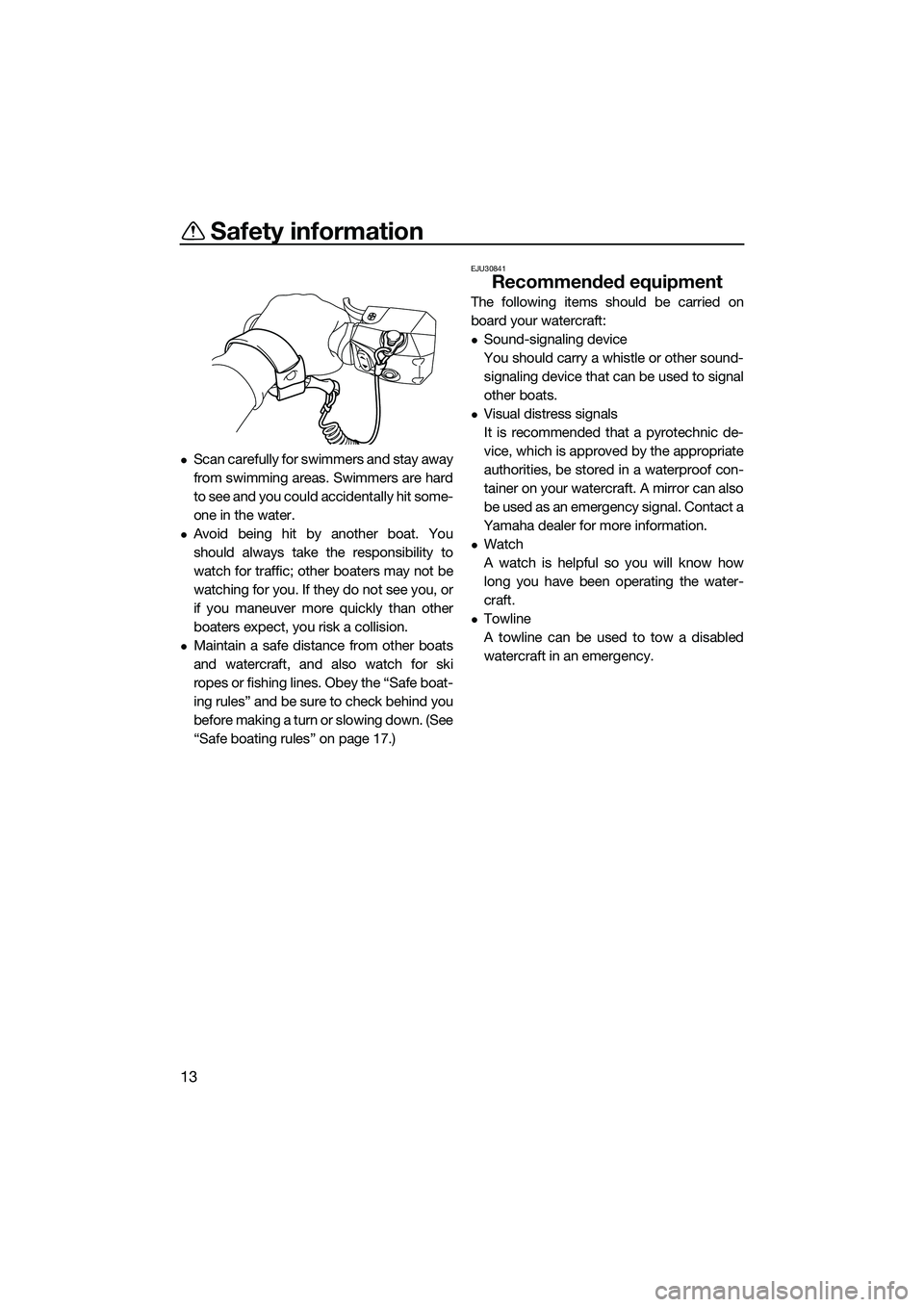
Safety information
13
Scan carefully for swimmers and stay away
from swimming areas. Swimmers are hard
to see and you could accidentally hit some-
one in the water.
Avoid being hit by another boat. You
should always take the responsibility to
watch for traffic; other boaters may not be
watching for you. If they do not see you, or
if you maneuver more quickly than other
boaters expect, you risk a collision.
Maintain a safe distance from other boats
and watercraft, and also watch for ski
ropes or fishing lines. Obey the “Safe boat-
ing rules” and be sure to check behind you
before making a turn or slowing down. (See
“Safe boating rules” on page 17.)
EJU30841
Recommended equipment
The following items should be carried on
board your watercraft:
Sound-signaling device
You should carry a whistle or other sound-
signaling device that can be used to signal
other boats.
Visual distress signals
It is recommended that a pyrotechnic de-
vice, which is approved by the appropriate
authorities, be stored in a waterproof con-
tainer on your watercraft. A mirror can also
be used as an emergency signal. Contact a
Yamaha dealer for more information.
Watch
A watch is helpful so you will know how
long you have been operating the water-
craft.
Towline
A towline can be used to tow a disabled
watercraft in an emergency.
UF3V73E0.book Page 13 Friday, October 8, 2021 1:30 PM
Page 23 of 136
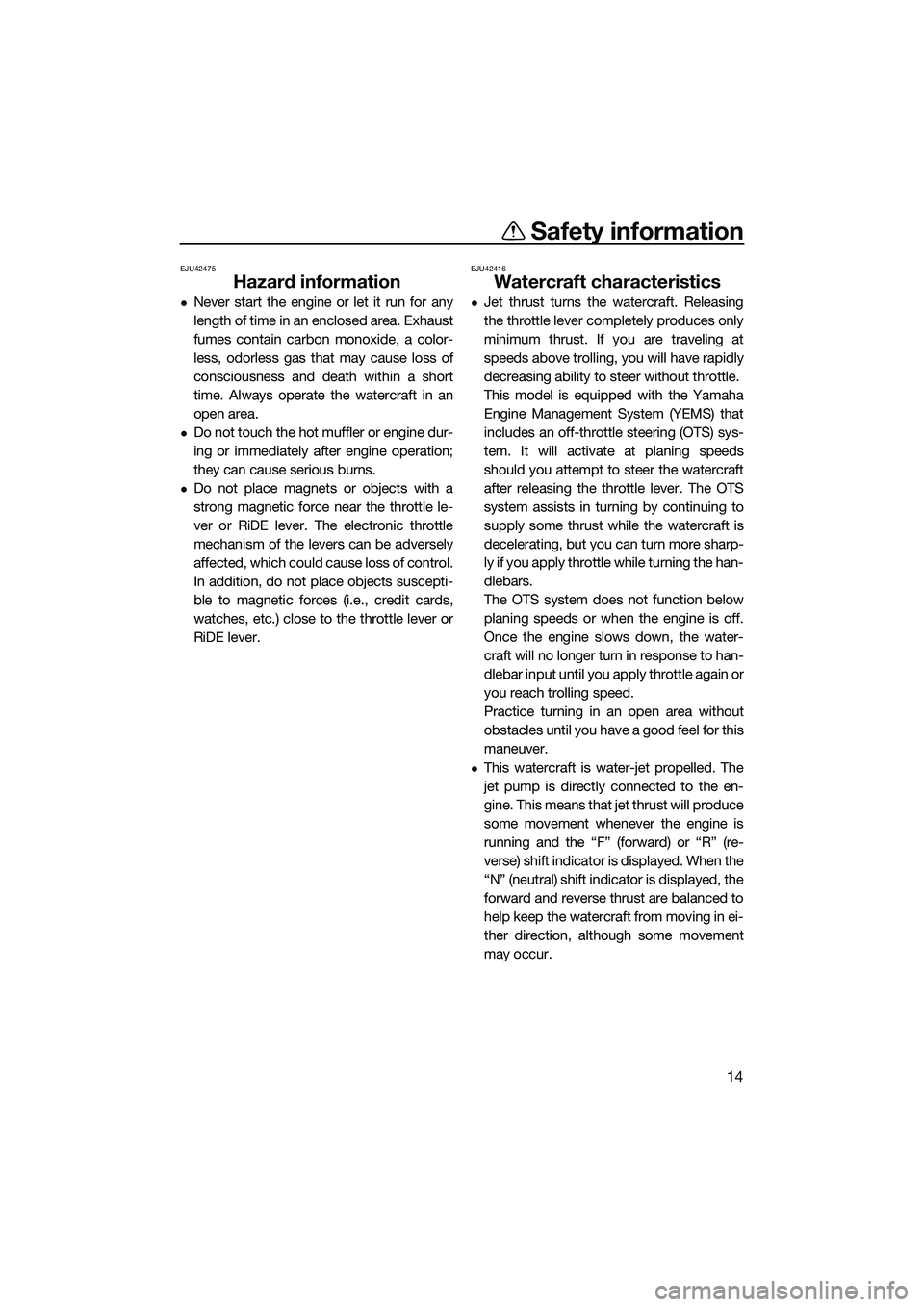
Safety information
14
EJU42475
Hazard information
Never start the engine or let it run for any
length of time in an enclosed area. Exhaust
fumes contain carbon monoxide, a color-
less, odorless gas that may cause loss of
consciousness and death within a short
time. Always operate the watercraft in an
open area.
Do not touch the hot muffler or engine dur-
ing or immediately after engine operation;
they can cause serious burns.
Do not place magnets or objects with a
strong magnetic force near the throttle le-
ver or RiDE lever. The electronic throttle
mechanism of the levers can be adversely
affected, which could cause loss of control.
In addition, do not place objects suscepti-
ble to magnetic forces (i.e., credit cards,
watches, etc.) close to the throttle lever or
RiDE lever.
EJU42416
Watercraft characteristics
Jet thrust turns the watercraft. Releasing
the throttle lever completely produces only
minimum thrust. If you are traveling at
speeds above trolling, you will have rapidly
decreasing ability to steer without throttle.
This model is equipped with the Yamaha
Engine Management System (YEMS) that
includes an off-throttle steering (OTS) sys-
tem. It will activate at planing speeds
should you attempt to steer the watercraft
after releasing the throttle lever. The OTS
system assists in turning by continuing to
supply some thrust while the watercraft is
decelerating, but you can turn more sharp-
ly if you apply throttle while turning the han-
dlebars.
The OTS system does not function below
planing speeds or when the engine is off.
Once the engine slows down, the water-
craft will no longer turn in response to han-
dlebar input until you apply throttle again or
you reach trolling speed.
Practice turning in an open area without
obstacles until you have a good feel for this
maneuver.
This watercraft is water-jet propelled. The
jet pump is directly connected to the en-
gine. This means that jet thrust will produce
some movement whenever the engine is
running and the “F” (forward) or “R” (re-
verse) shift indicator is displayed. When the
“N” (neutral) shift indicator is displayed, the
forward and reverse thrust are balanced to
help keep the watercraft from moving in ei-
ther direction, although some movement
may occur.
UF3V73E0.book Page 14 Friday, October 8, 2021 1:30 PM
Page 24 of 136
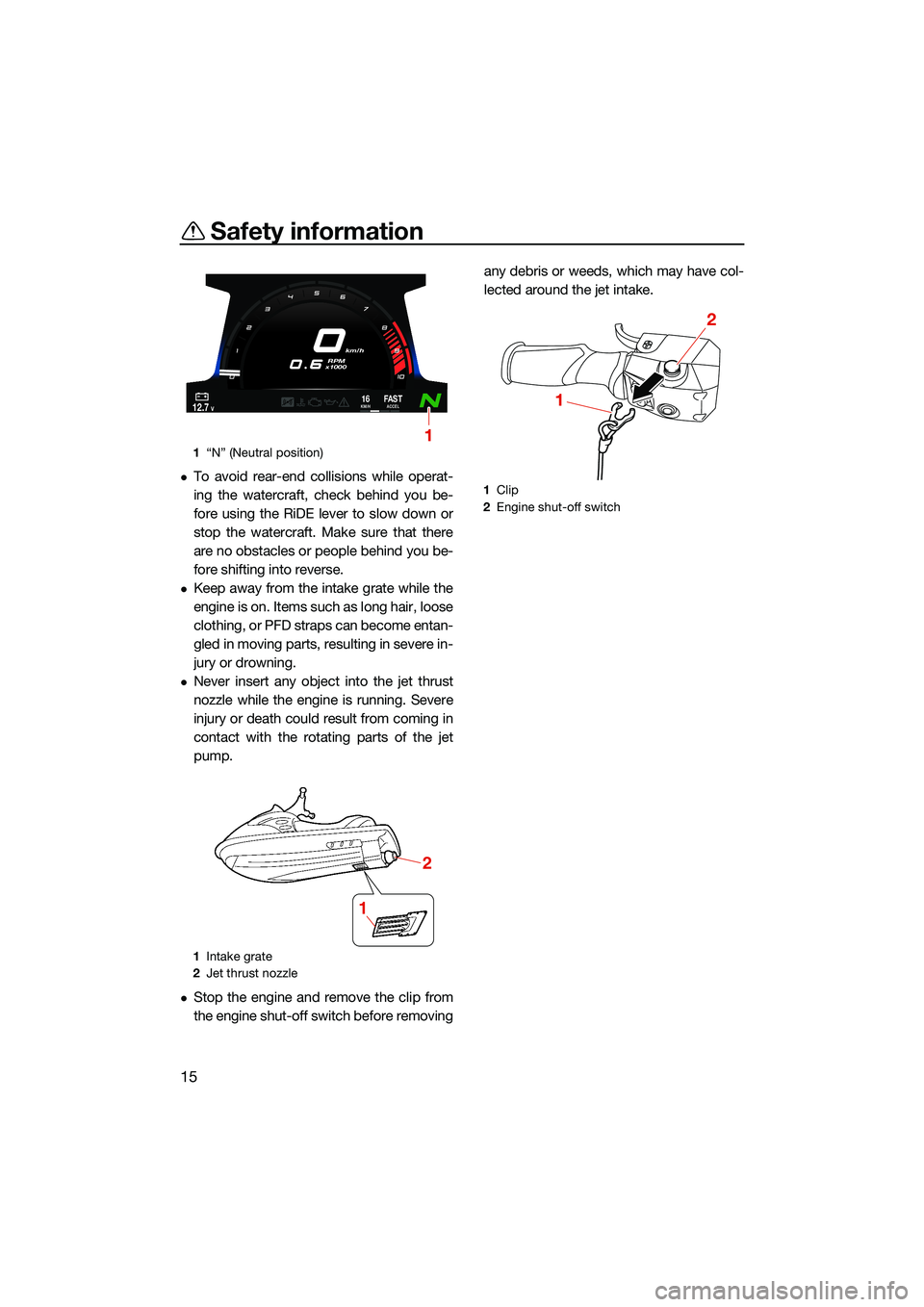
Safety information
15
To avoid rear-end collisions while operat-
ing the watercraft, check behind you be-
fore using the RiDE lever to slow down or
stop the watercraft. Make sure that there
are no obstacles or people behind you be-
fore shifting into reverse.
Keep away from the intake grate while the
engine is on. Items such as long hair, loose
clothing, or PFD straps can become entan-
gled in moving parts, resulting in severe in-
jury or drowning.
Never insert any object into the jet thrust
nozzle while the engine is running. Severe
injury or death could result from coming in
contact with the rotating parts of the jet
pump.
Stop the engine and remove the clip from
the engine shut-off switch before removingany debris or weeds, which may have col-
lected around the jet intake.
1
“N” (Neutral position)
1 Intake grate
2 Jet thrust nozzle
km/h
RPM
x1000
12.7V16KM/HFA S TACCEL
1
1
2
1 Clip
2 Engine shut-off switch
1
2
UF3V73E0.book Page 15 Friday, October 8, 2021 1:30 PM
Page 25 of 136
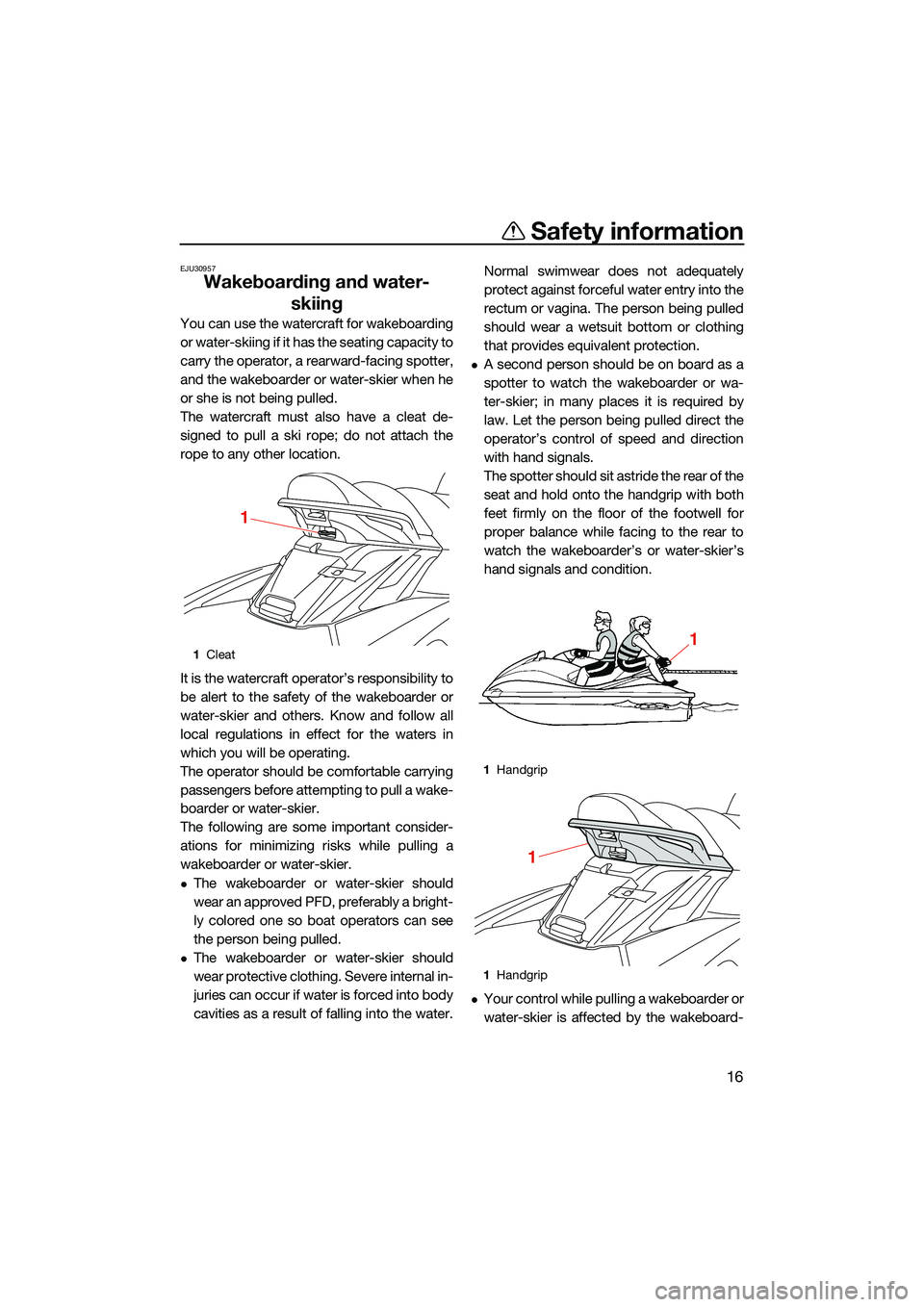
Safety information
16
EJU30957
Wakeboarding and water-skiing
You can use the watercraft for wakeboarding
or water-skiing if it has the seating capacity to
carry the operator, a rearward-facing spotter,
and the wakeboarder or water-skier when he
or she is not being pulled.
The watercraft must also have a cleat de-
signed to pull a ski rope; do not attach the
rope to any other location.
It is the watercraft operator’s responsibility to
be alert to the safety of the wakeboarder or
water-skier and others. Know and follow all
local regulations in effect for the waters in
which you will be operating.
The operator should be comfortable carrying
passengers before attempting to pull a wake-
boarder or water-skier.
The following are some important consider-
ations for minimizing risks while pulling a
wakeboarder or water-skier.
The wakeboarder or water-skier should
wear an approved PFD, preferably a bright-
ly colored one so boat operators can see
the person being pulled.
The wakeboarder or water-skier should
wear protective clothing. Severe internal in-
juries can occur if water is forced into body
cavities as a result of falling into the water. Normal swimwear does not adequately
protect against forceful water entry into the
rectum or vagina. The person being pulled
should wear a wetsuit bottom or clothing
that provides equivalent protection.
A second person should be on board as a
spotter to watch the wakeboarder or wa-
ter-skier; in many places it is required by
law. Let the person being pulled direct the
operator’s control of speed and direction
with hand signals.
The spotter should sit astride the rear of the
seat and hold onto the handgrip with both
feet firmly on the floor of the footwell for
proper balance while facing to the rear to
watch the wakeboarder’s or water-skier’s
hand signals and condition.
Your control while pulling a wakeboarder or
water-skier is affected by the wakeboard-
1
Cleat
1
1Handgrip
1 Handgrip
1
1
UF3V73E0.book Page 16 Friday, October 8, 2021 1:30 PM
Page 26 of 136
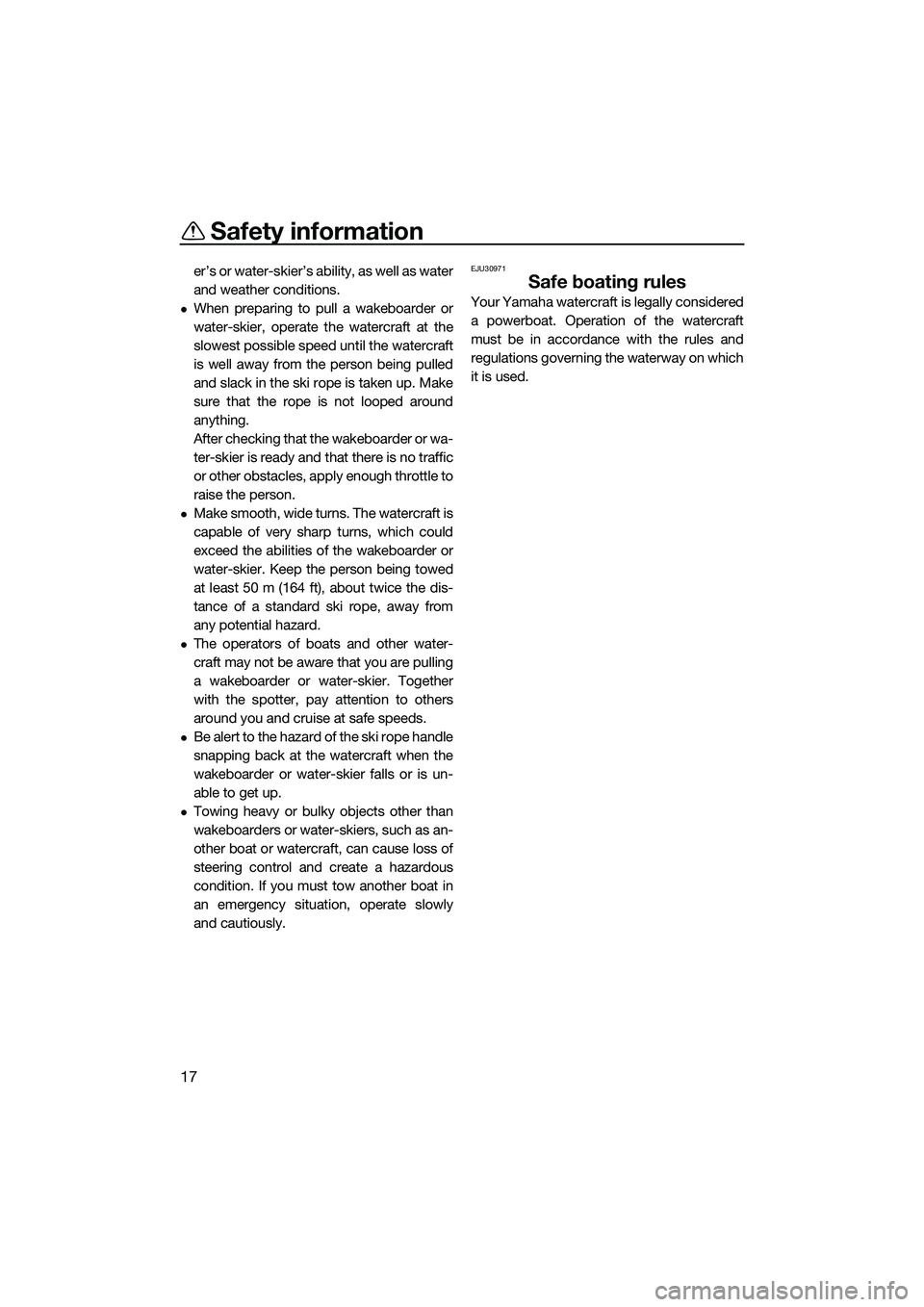
Safety information
17
er’s or water-skier’s ability, as well as water
and weather conditions.
When preparing to pull a wakeboarder or
water-skier, operate the watercraft at the
slowest possible speed until the watercraft
is well away from the person being pulled
and slack in the ski rope is taken up. Make
sure that the rope is not looped around
anything.
After checking that the wakeboarder or wa-
ter-skier is ready and that there is no traffic
or other obstacles, apply enough throttle to
raise the person.
Make smooth, wide turns. The watercraft is
capable of very sharp turns, which could
exceed the abilities of the wakeboarder or
water-skier. Keep the person being towed
at least 50 m (164 ft), about twice the dis-
tance of a standard ski rope, away from
any potential hazard.
The operators of boats and other water-
craft may not be aware that you are pulling
a wakeboarder or water-skier. Together
with the spotter, pay attention to others
around you and cruise at safe speeds.
Be alert to the hazard of the ski rope handle
snapping back at the watercraft when the
wakeboarder or water-skier falls or is un-
able to get up.
Towing heavy or bulky objects other than
wakeboarders or water-skiers, such as an-
other boat or watercraft, can cause loss of
steering control and create a hazardous
condition. If you must tow another boat in
an emergency situation, operate slowly
and cautiously.
EJU30971
Safe boating rules
Your Yamaha watercraft is legally considered
a powerboat. Operation of the watercraft
must be in accordance with the rules and
regulations governing the waterway on which
it is used.
UF3V73E0.book Page 17 Friday, October 8, 2021 1:30 PM
Page 27 of 136
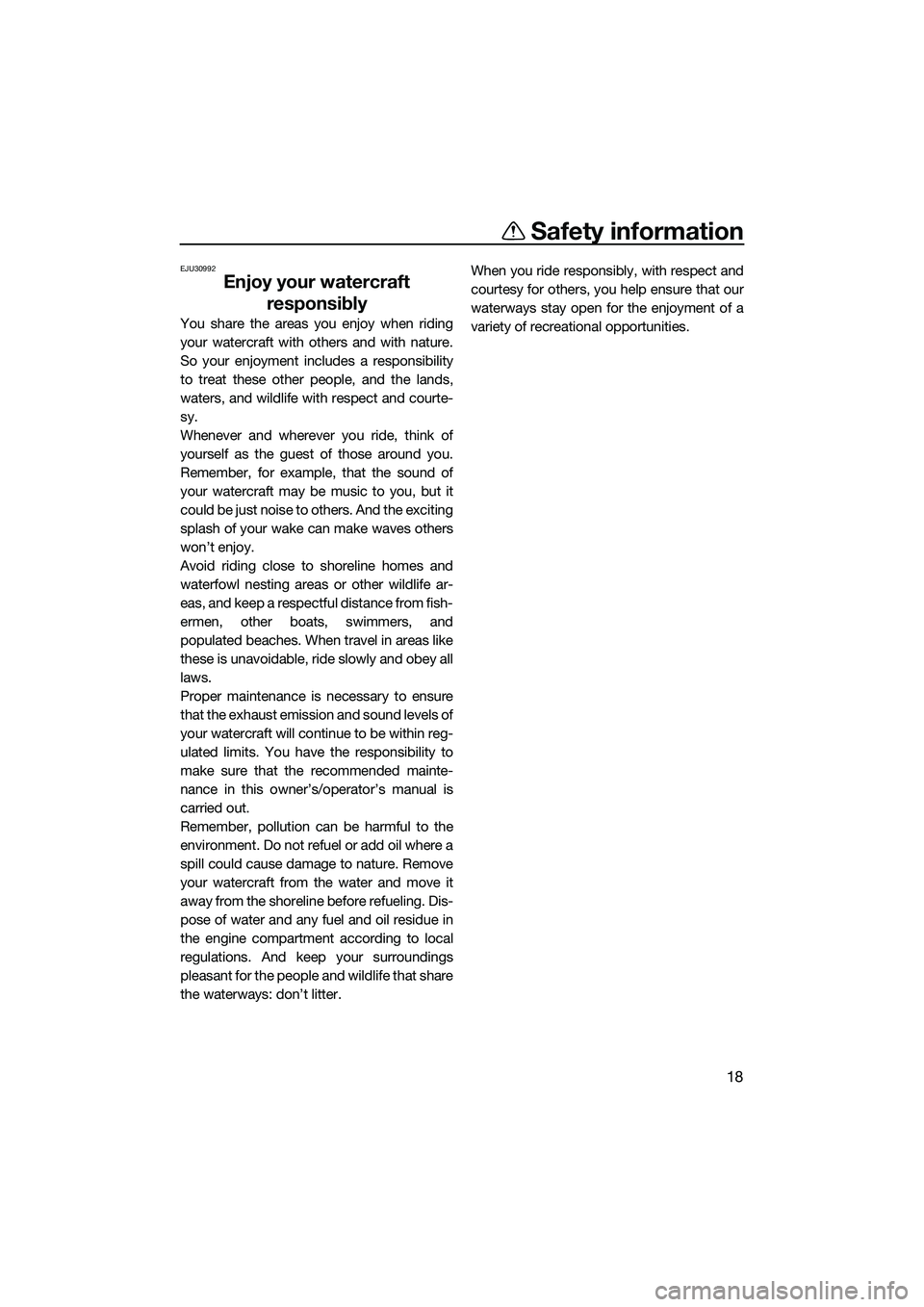
Safety information
18
EJU30992
Enjoy your watercraft responsibly
You share the areas you enjoy when riding
your watercraft with others and with nature.
So your enjoyment includes a responsibility
to treat these other people, and the lands,
waters, and wildlife with respect and courte-
sy.
Whenever and wherever you ride, think of
yourself as the guest of those around you.
Remember, for example, that the sound of
your watercraft may be music to you, but it
could be just noise to others. And the exciting
splash of your wake can make waves others
won’t enjoy.
Avoid riding close to shoreline homes and
waterfowl nesting areas or other wildlife ar-
eas, and keep a respectful distance from fish-
ermen, other boats, swimmers, and
populated beaches. When travel in areas like
these is unavoidable, ride slowly and obey all
laws.
Proper maintenance is necessary to ensure
that the exhaust emission and sound levels of
your watercraft will continue to be within reg-
ulated limits. You have the responsibility to
make sure that the recommended mainte-
nance in this owner’s/operator’s manual is
carried out.
Remember, pollution can be harmful to the
environment. Do not refuel or add oil where a
spill could cause damage to nature. Remove
your watercraft from the water and move it
away from the shoreline before refueling. Dis-
pose of water and any fuel and oil residue in
the engine compartment according to local
regulations. And keep your surroundings
pleasant for the people and wildlife that share
the waterways: don’t litter. When you ride responsibly, with respect and
courtesy for others, you help ensure that our
waterways stay open for the enjoyment of a
variety of recreational opportunities.
UF3V73E0.book Page 18 Friday, October 8, 2021 1:30 PM
Page 28 of 136
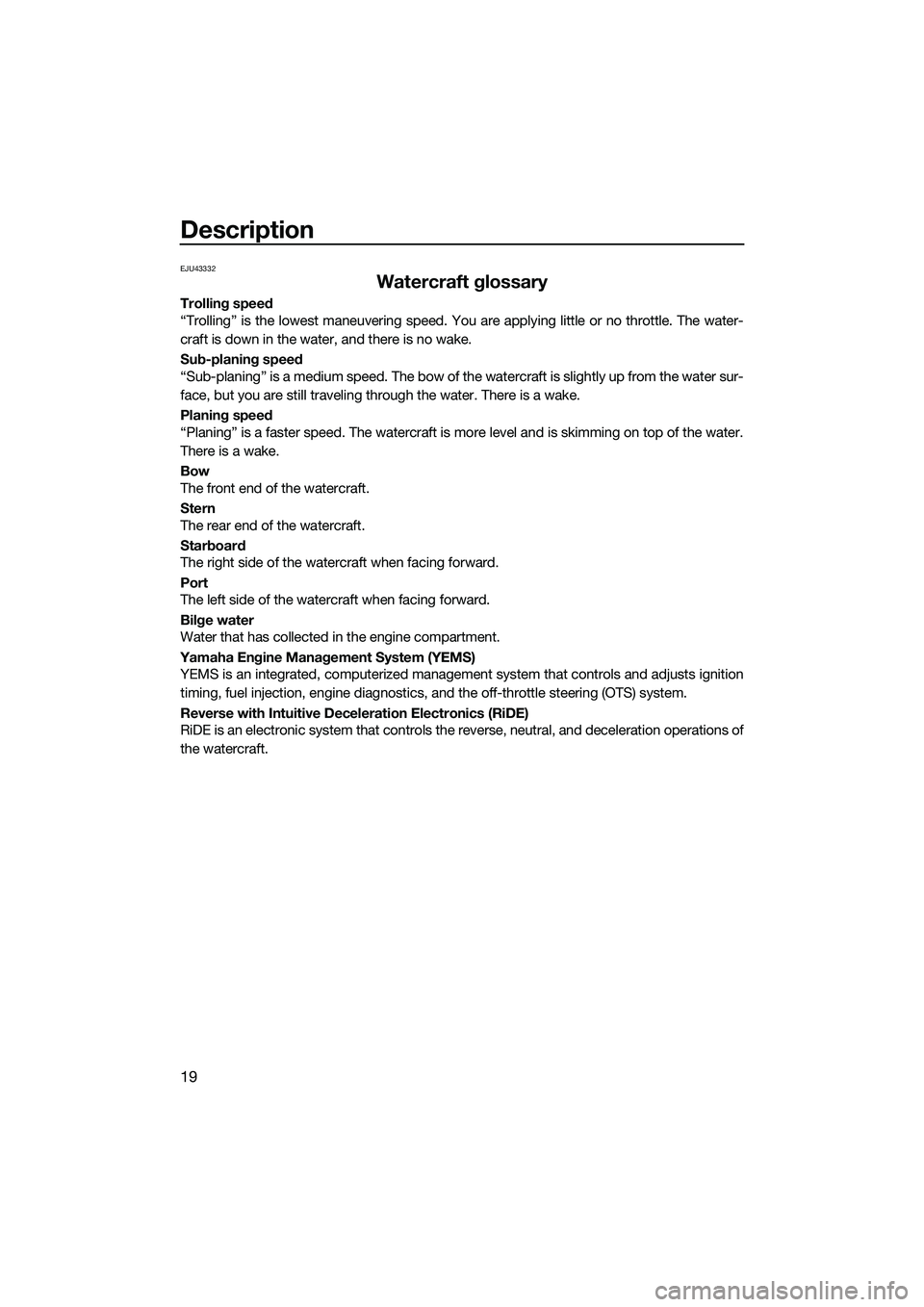
Description
19
EJU43332
Watercraft glossary
Trolling speed
“Trolling” is the lowest maneuvering speed. You are applying little or no throttle. The water-
craft is down in the water, and there is no wake.
Sub-planing speed
“Sub-planing” is a medium speed. The bow of the watercraft is slightly up from the water sur-
face, but you are still traveling through the water. There is a wake.
Planing speed
“Planing” is a faster speed. The watercraft is more level and is skimming on top of the water.
There is a wake.
Bow
The front end of the watercraft.
Stern
The rear end of the watercraft.
Starboard
The right side of the watercraft when facing forward.
Port
The left side of the watercraft when facing forward.
Bilge water
Water that has collected in the engine compartment.
Yamaha Engine Management System (YEMS) YEMS is an integrated, computerized management system that controls and adjusts ignition
timing, fuel injection, engine diagnostics, and the off-throttle steering (OTS) system.
Reverse with Intuitive Deceleration Electronics (RiDE)
RiDE is an electronic system that controls the reverse, neutral, and deceleration operations of
the watercraft.
UF3V73E0.book Page 19 Friday, October 8, 2021 1:30 PM
Page 29 of 136
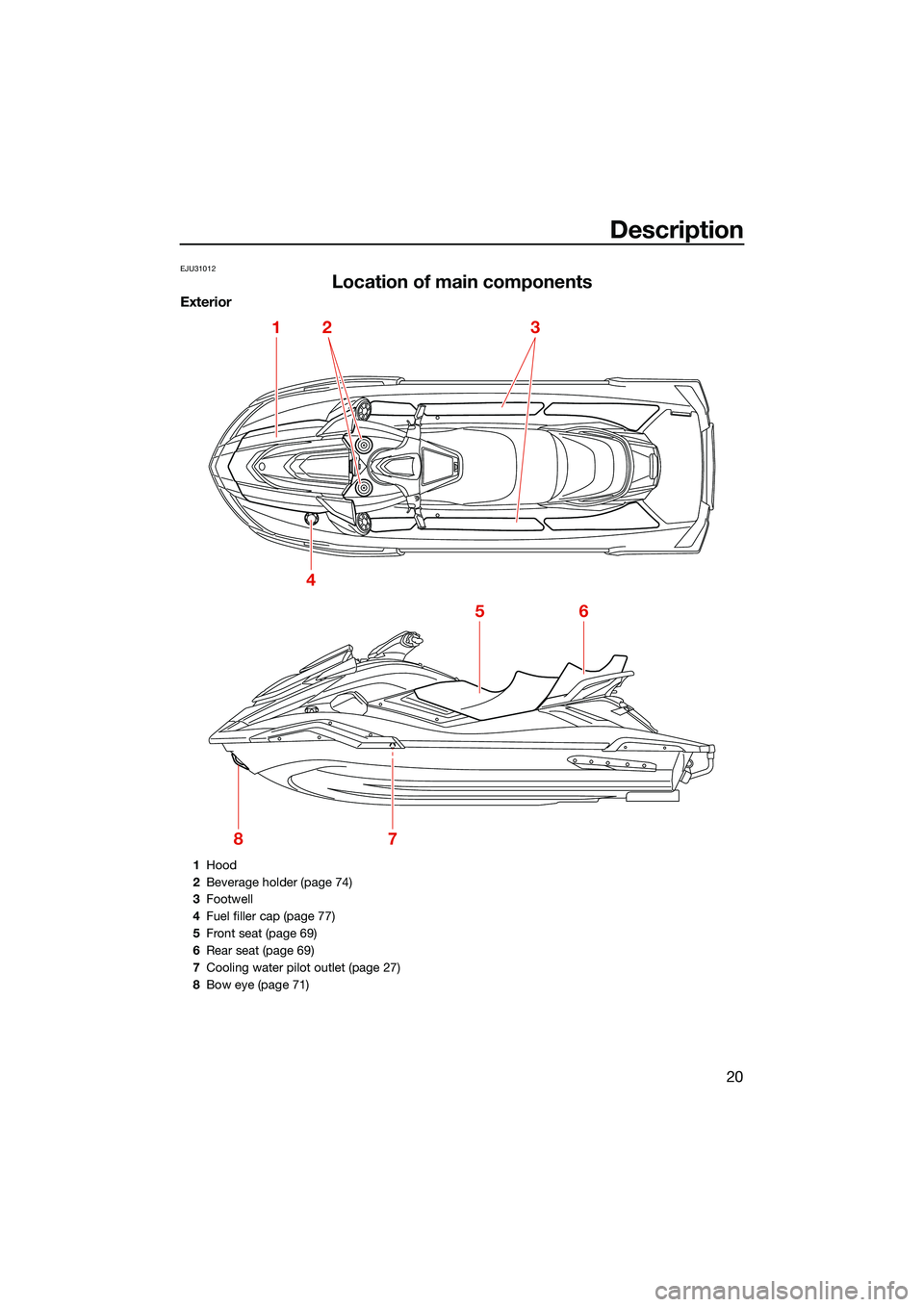
Description
20
EJU31012
Location of main components
Exterior
1
4
56
78
23
1Hood
2 Beverage holder (page 74)
3 Footwell
4 Fuel filler cap (page 77)
5 Front seat (page 69)
6 Rear seat (page 69)
7 Cooling water pilot outlet (page 27)
8 Bow eye (page 71)
UF3V73E0.book Page 20 Friday, October 8, 2021 1:30 PM
Page 30 of 136
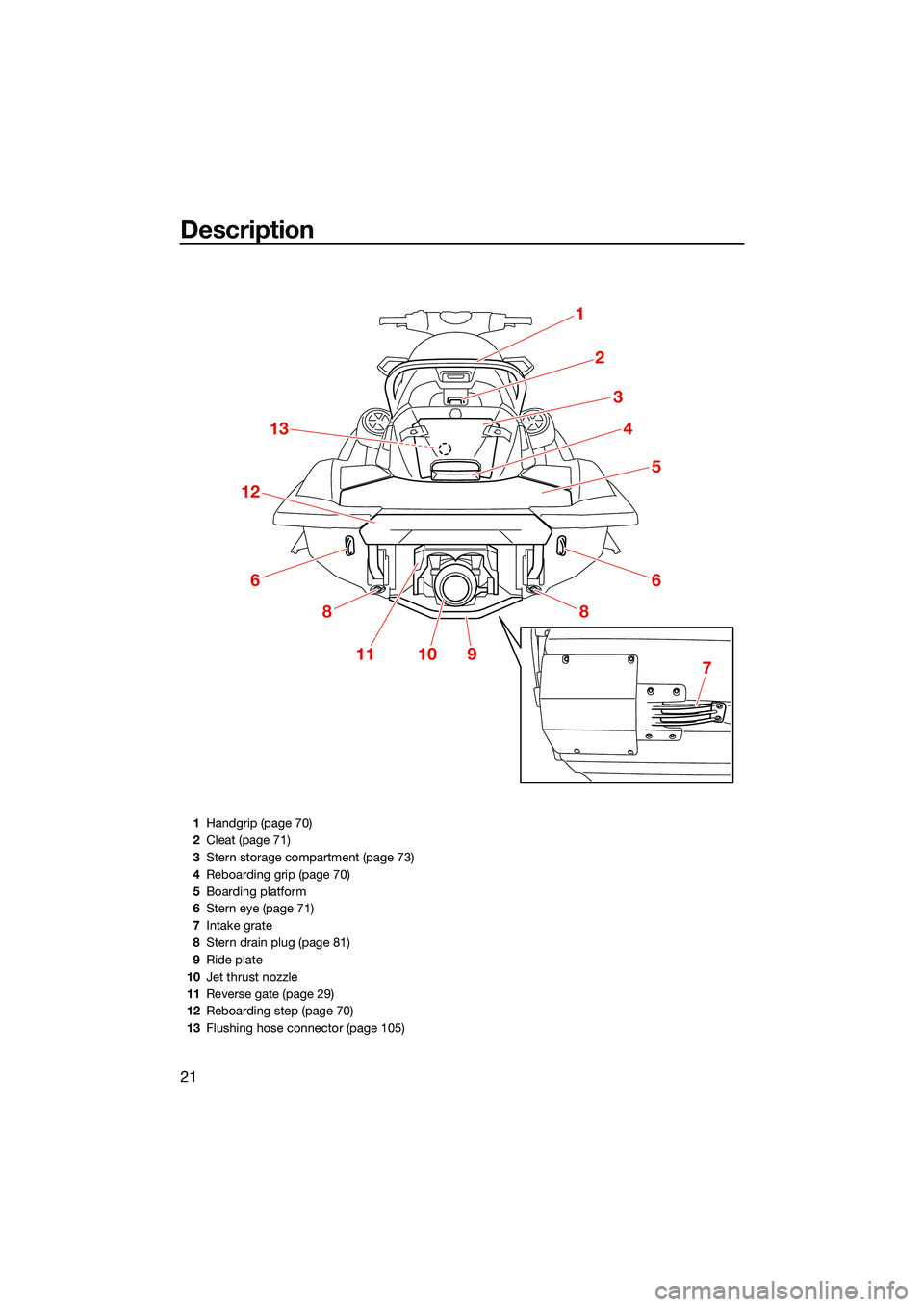
Description
21
1
2
3
4
5
6
8
13
12
6
8
111097
1Handgrip (page 70)
2 Cleat (page 71)
3 Stern storage compartment (page 73)
4 Reboarding grip (page 70)
5 Boarding platform
6 Stern eye (page 71)
7 Intake grate
8 Stern drain plug (page 81)
9 Ride plate
10 Jet thrust nozzle
11 Reverse gate (page 29)
12 Reboarding step (page 70)
13 Flushing hose connector (page 105)
UF3V73E0.book Page 21 Friday, October 8, 2021 1:30 PM